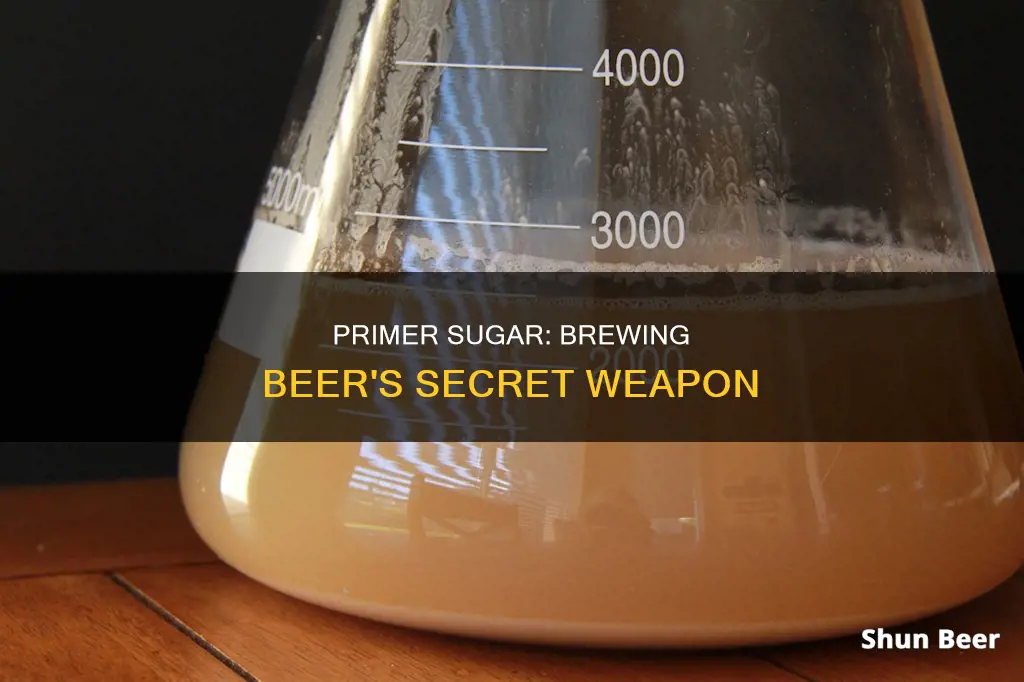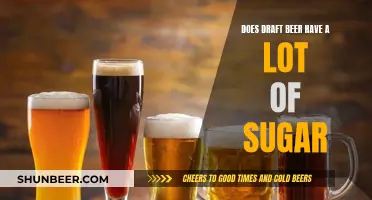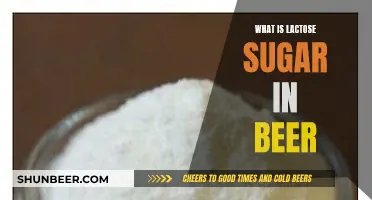
Priming sugar is an essential component in the priming solution used to carbonate beer. It is added to a fermented beer before bottling and can be corn sugar, table sugar, or dry malt extract. The sugar is food for the yeast, which creates carbonation in the form of carbon dioxide (CO2) as it ferments in the bottle, resulting in a bubbly brew. The amount of priming sugar used depends on the desired carbonation level and the type of beer being brewed. While it is possible to drink beer without carbonation, priming sugar helps bring out the best flavours and adds a thirst-quenching zing to the beverage.
| Characteristics | Values |
|---|---|
| Purpose | Prepare homebrew for carbonation in bottles |
| How it works | Yeast converts the sugar into CO2 inside sealed bottles to create carbonation |
| When to add | After fermentation is complete, right before bottling the beer |
| How much to add | 1 oz of priming sugar for 1 gallon of beer; 5 oz for a 5-gallon batch |
| Types | Corn sugar, table sugar, dry malt extract, honey, molasses, maple syrup, and more |
| Effects | Creates carbonation and can influence flavour, sweetness, and colour |
| Dissolving | Dissolve priming sugar in boiling water to ensure even distribution and consistent carbonation |
| Skip? | Can be skipped for non-carbonated or still beer |
What You'll Learn

Primer sugar is used to carbonate beer
The most popular forms of priming sugar are corn sugar, table sugar, and dry malt extract (DME). Corn sugar is the most widely available commercial priming sugar and is often included in homebrew kits. It is favoured for its high fermentability, low moisture content, and neutral flavour. It is also very soluble and easy for the yeast to digest. Table sugar is a good alternative, as it is inexpensive and widely available, but you will need slightly less of it than corn sugar. DME is an unfermented wort that has been dried into powder form, and it will add flavour and body to the beer.
The amount of priming sugar needed depends on the type and volume of the beverage. For a 5-gallon batch of beer, the rule of thumb is 3/4 cup of corn sugar, 2/3 cup of table sugar, or 1 1/4 cups of DME.
To prepare a priming solution, combine the priming sugar with water in a large pot and stir over medium-high heat until the sugar is dissolved. Then, boil the mixture for 5 minutes, remove from the heat, and let it cool completely. Once cooled, transfer your beer into the pot with the priming solution and gently stir to combine. Now your beer is ready to bottle and will be primed for carbonation!
Milk Sugar in Beer: What's the Sweet Deal?
You may want to see also

Yeast converts primer sugar into CO2
Priming sugar is added to beer before bottling, and it's essential for achieving the desired level of carbonation. The most common types of priming sugar are corn sugar, table sugar, and dry malt extract (DME). These sugars provide food for the yeast, which then produces carbon dioxide (CO2) as a byproduct. This CO2 gets trapped in the beer, creating carbonation and those satisfying bubbles we associate with a refreshing brew.
The amount of priming sugar used depends on the volume and type of beverage being made. For a 5-gallon batch of beer, the general rule of thumb is to use 3/4 cup of corn sugar, 2/3 cup of table sugar, or 1 1/4 cups of DME. However, it's important to note that each type of sugar has a different volume and fermentability, so adjustments may be necessary to hit the desired carbonation level.
The choice of priming sugar can also impact the flavour, sweetness, and colour of the beer. While corn sugar and cane sugar are neutral in taste, DME can influence the flavour since it's made from grains. Additionally, natural unrefined sugars like dark brown sugar or honey can enhance the taste and aroma of the beer while still providing the necessary carbonation.
The process of adding priming sugar involves dissolving the sugar in boiling water, creating a priming solution. This solution is then carefully mixed with the beer to ensure even distribution. The beer is then bottled, and the yeast continues to work, converting the sugar into CO2 and creating a bubbly, carbonated brew.
Heineken Beer's Sweet Secret: Sugar Content Revealed
You may want to see also

Primer sugar is added to beer after fermentation
Primer sugar is typically dissolved in water and boiled before being added to the beer. This ensures that the sugar is evenly distributed throughout the brew, resulting in consistent carbonation in every bottle. The amount of primer sugar added will depend on the desired level of carbonation and the type of sugar used. Too much primer sugar can result in over-carbonation and excessive foaming, while too little can lead to under-carbonated beer.
The most popular forms of primer sugar are corn sugar, table sugar, and dry malt extract (DME). Corn sugar is a good option for new brewers as it does not influence the taste of the finished beer. Table sugar is less expensive and readily available, but it may produce inconsistent results. Dry malt extract can add flavour and body to the beer and may result in finer bubbles.
Other options for primer sugar include brown sugar, honey, and various sugar substitutes such as demerara sugar, agave nectar, treacle, maple syrup, molasses, and Belgian candi syrup. These alternatives can add unique flavours and aromas to the beer.
The choice of primer sugar depends on the brewer's preference and the desired outcome for the beer. It is important to understand the effects of different sugars on the flavour, sweetness, and colour of the brew. Experimentation is encouraged to find the perfect balance for each batch of beer.
The Science Behind Sugar in Beer
You may want to see also

Primer sugar is dissolved in water before adding to beer
Primer sugar is essential to achieving the perfect level of carbonation in your beer. It is the main component in the priming solution, which is added to the brew as you bottle it. Yeast converts this sugar into carbon dioxide (CO2) inside the sealed bottles, creating a fizziness in your beer.
Primer sugar is typically corn sugar (dextrose), table sugar (sucrose), or dry malt extract (DME). The amount of sugar needed depends on the volume of beer you are brewing and the desired level of carbonation. For example, for a 1-gallon batch, you would typically use 1 ounce (2 tablespoons) of priming sugar, while for a 5-gallon batch, you would use 5 ounces (2/3 cup).
Primer sugar is dissolved in water before adding it to the beer to create a priming solution. This is done by combining the sugar and water in a large pot and heating it over medium-high heat while stirring until the sugar is completely dissolved. The mixture is then boiled for 5 minutes, removed from the heat, covered, and allowed to cool completely.
Dissolving primer sugar in water before adding it to the beer ensures that it is evenly distributed and helps to create consistent carbonation throughout the brew. It also makes it easier to mix the priming solution with the beer, as it is already in a liquid form.
Once the priming solution is ready, it can be added to the bottling bucket along with the beer, gently stirred to combine, and then bottled. The bottled beer is then set aside in a dry, room-temperature place to allow the yeast to remain active and generate carbonation. After about two weeks, the beer will be carbonated and ready to drink!
Cider Beers: Sugar Content and Health Considerations
You may want to see also

Corn sugar, table sugar, and dry malt extract are common primer sugars
Corn sugar, also known as dextrose, is a good all-purpose primer sugar for a 5-gallon batch of beer. It is favoured for its high fermentability, low moisture content, and neutral flavour. It is also highly refined and does not contain any corn character.
Table sugar, or sucrose, works just as well as corn sugar and is a cheaper alternative. It is 100% sweet stuff, so you need to use about 10% less table sugar by weight than you would corn sugar when priming your beer.
Dry malt extract (DME) can be used in a pinch but is more expensive than corn sugar or table sugar. It will also cause a little Kräusen ring to form in the necks of your bottles, but this is harmless and won't affect the beer.
Starch and Sugar in Beer: What's the Truth?
You may want to see also
Frequently asked questions
Primer sugar is added to beer before bottling to create carbonation. The yeast converts the sugar into carbon dioxide (CO2) inside the sealed bottles, making the beer fizzy.
The amount of primer sugar needed depends on the type and volume of the beverage. As a rule of thumb, 3/4 cup of corn sugar is needed for 5 gallons of beer.
Corn sugar, table sugar, and dry malt extract (DME) are the most popular forms of primer sugar. However, any sugar that is fermentable can be used, such as honey, maple syrup, or molasses.







